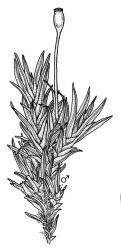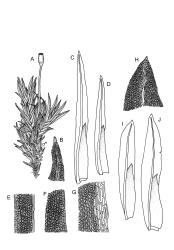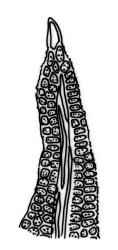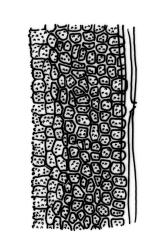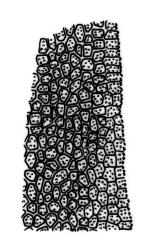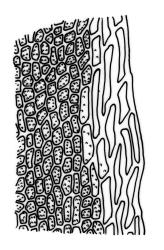- ≡ Fissidens humilis var. angustifolius Dixon, Bot. Not. 1937: 64 (1937)
- = Fissidens aeruginosus Hook.f. & Wilson in Wilson, Bot. Antarct. Voy. II (Fl. Nov.-Zel.) Part II, 62 (1854)
- ≡ Fissidens linearis var. aeruginosus (Hook.f. & Wilson) I.G.Stone, J. Bryol. 16: 404 (1991) nom. illeg.
- = Fissidens abbreviatus Mitt. in Seemann, Fl. Viti. 385 (1873)
Stems frequently branched, with rhizoids at base of stems, or on prostrate stems in contact with soil, and often at base of branches. Leaves linear, 0.8–1.4 × 0.1–0.2 mm; apex narrowly acute, often asymmetric; vaginant laminae often ˂½ leaf length.
Autoicous. Perichaetia terminal on main or axillary shoots. Perigonia terminal on short axillary shoots. Spores 8–11 µm.
Wilson 1854, pl. 83, fig. 5 (as F. aeruginosus); Stone 1990a, figs 1, a–s, 2, a–e, 4, u–y (as F. aeruginosus var. aeruginosus); Beever et al. 2002, p. 40, figs 1–4.
K; NI: N Auckland, including offshore islands (TK, PK, HC, LB, GB), S Auckland, Gisborne, Hawke’s Bay, Taranaki, Wellington (including KA); SI: Nelson (including D’U), Marlborough, Westland (Lake Moeraki); Ch. A report from Vanuatu (Suzuki & Iwatsuki 2002) is considered to be based on a misidentification.
Endemic.
On soil, especially shaded eroding banks in indigenous forest. Associates commonly include other soil-dwelling species of Fissidens: F. asplenioides, F. blechnoides, F. curvatus, F. dealbatus, F. leptocladus, F. pallidus, and F. tenellus var. tenellus. This variety has been recorded from near sea level to 450 m (Hira State Forest, Nelson L.D.).
Although intermediates with the type variety sometimes occur, in its representative form the var. angustifolius is highly distinctive in the shape of its leaves. In addition, it extends much further south than var. linearis (which is not known south of the central North I., Chatham Is excepted). For these reasons, the var. angustifolius deserves taxonomic recognition, at least until molecular studies provide additional information.



